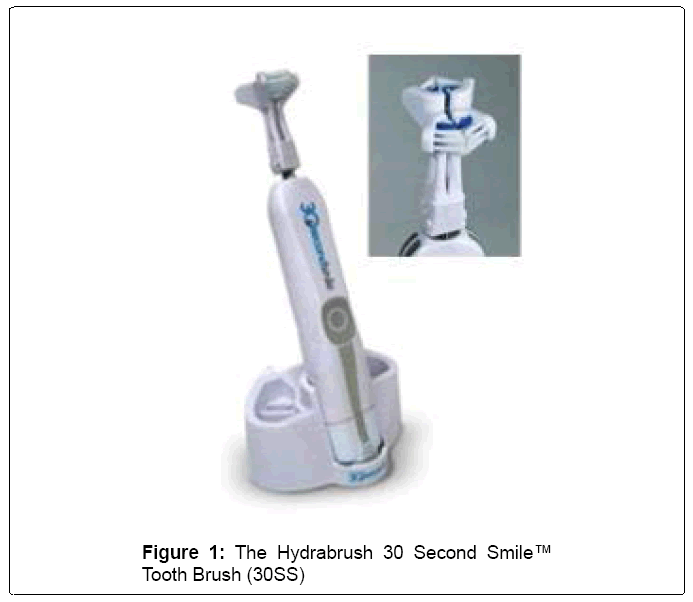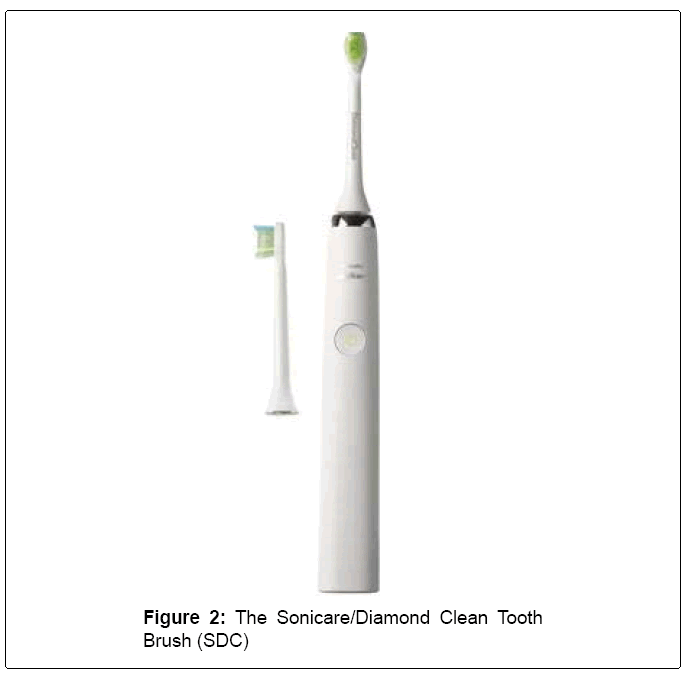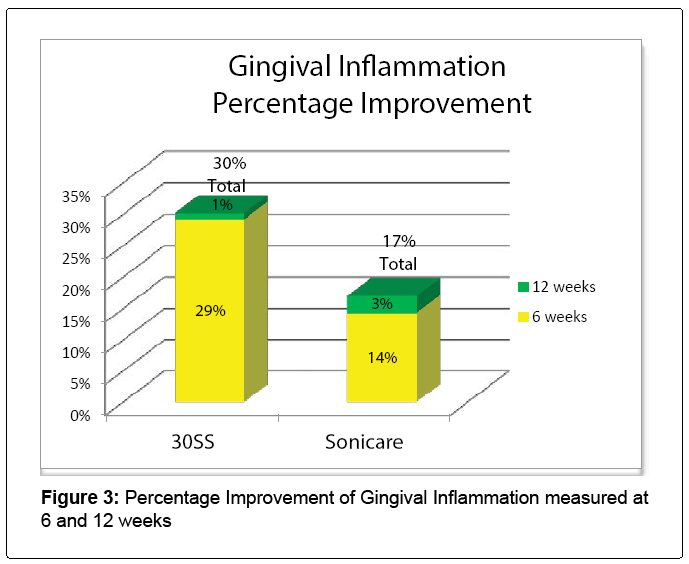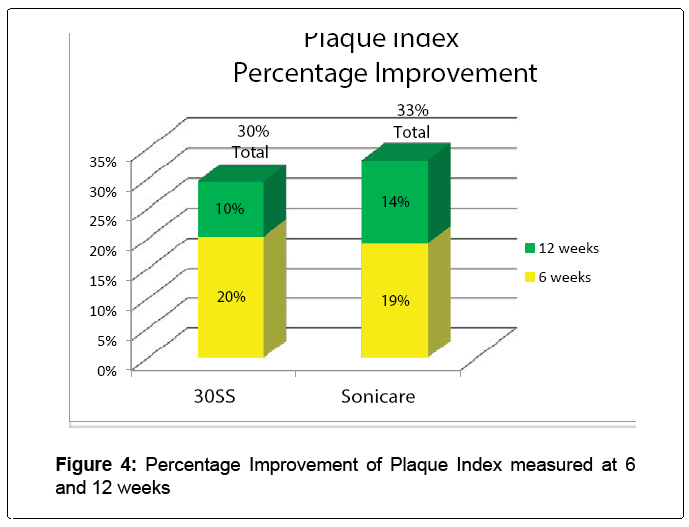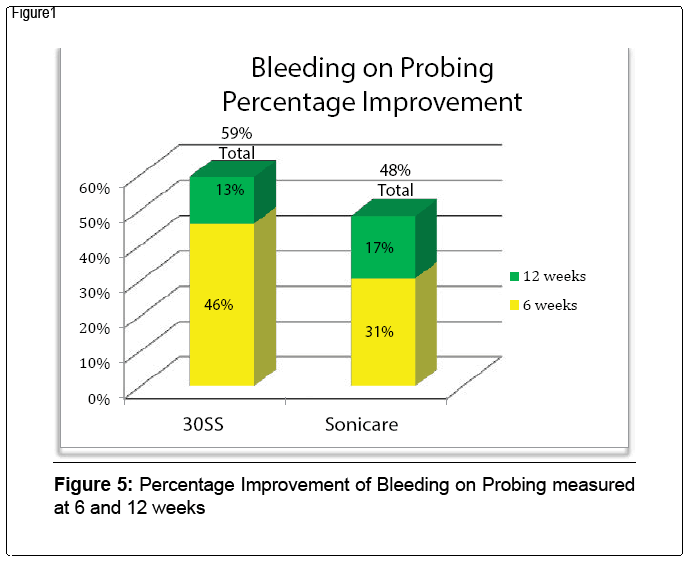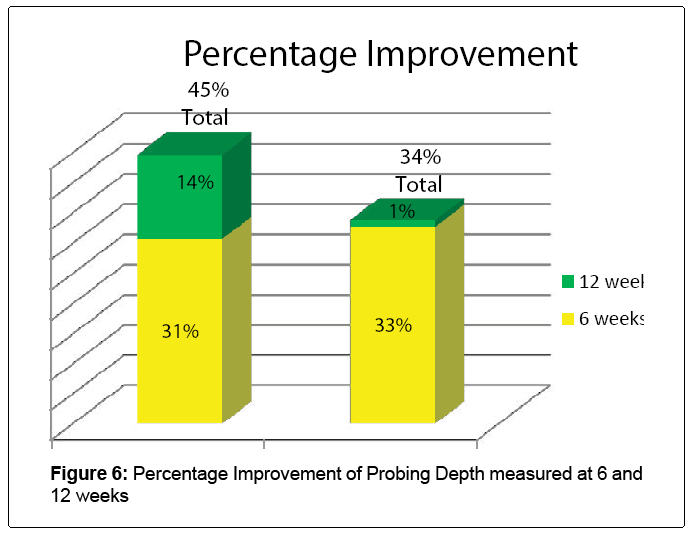Research Article Open Access
The Hydrabrush/30 Second Smile™ Tooth Brush- Improving Gingival Health in Less Time, A Randomized Clinical Trial
J. Kobi Stern1#*, Darron R Alvord2#, Stephen W Looney3, Ranjitha Krishna1, Patrick Basquil1, Ilanit Stern4 and Regina L Woods11Department of Periodontics, College of Dental Medicine, Georgia Regents University, USA
2Private Practice, Savannah, Georgia, USA
3Department of Biostatistics, College of Dental Medicine, Georgia Regents University, Georgia, USA
4Department of Oral Medicine, College of Dental Medicine, Georgia Regents University, Georgia, USA
#J.S and D.A. have equally contributed to this work.
- *Corresponding Author:
- J Kobi Stern, DMD, M.Sc
Department of Periodontics
College of Dental Medicine
Georgia Regents University, USA
Tel: 706-721-2442
E-mail: jastern@gru.edu
Received Date: March 28, 2015; Accepted Date: May 04, 2015; Published Date: May 12, 2015
Citation: Stern JK, Darron RA, Stephen WL, Krishna R, Basquil P, et al. (2015) The Hydrabrush/30 Second Smile™ Tooth Brush- Improving Gingival Health in Less Time, A Randomized Clinical Trial. J Oral Hyg Health 3:177. doi: 10.4172/2332-0702.1000177
Copyright: © 2015 Stern JK, et al. This is an open-access article distributed under the terms of the Creative Commons Attribution License, which permits unrestricted use, distribution, and reproduction in any medium, provided the original author and source are credited.
Visit for more related articles at Journal of Oral Hygiene & Health
Abstract
Objectives: The aim of this examiner-blinded, randomized controlled clinical trial was to compare the efficacy of a new innovative electric toothbrush used twice daily for only 30 seconds (Hydrabrush/30 Second Smile toothbrush)™ to a conventional electric toothbrush (Sonicare/Diamond Clean) that served as control used twice daily for 2 minutes.
Materials and Methods: 50 patients, with 25 patients in each group were randomly assigned to either the Hydrabrush/30 Second Smile or the Sonicare/Diamond Clean toothbrushes. Baseline periodontal examinations were performed for each patient, including: gingival inflammation (GI), plaque (PI), bleeding on probing (BOP), periodontal probing depths (PD), recession, furcation, and mobility. These periodontal parameters were evaluated at six weeks and at twelve weeks for each patient. Patients were instructed to strictly follow the manufacturer’s instructions for each toothbrush, and to refrain from all other oral hygiene measures.
Results: Although not statistically significant, the Hydrabrush/30 Second Smile toothbrush showed a greater reduction of GI and BOP when compared to the control brush. In addition, the Hydrabrush/30 Second Smile toothbrush was able to further reduce PD, BOP, and plaque over time thus displaying an additive effect that was statistically significant at 12 weeks compared to 6 weeks.
Conclusion: Concomitant with periodontal therapy provided to gingivitis and slight periodontitis patients, using the Hydrabrush/30 Second Smile toothbrush twice daily for only 30 seconds, can be equally effective as a conventional electric toothbrush used twice daily for 2 minutes, in improving gingival health over time.
Clinical significance: This study demonstrates that improved gingival health can be achieved in shorter brushing time using the Hydrabrush/30 Second Smile toothbrush. This may improve oral hygiene compliance for all patients, especially those with dexterity issues.
Keywords
Electric tooth brush, Oral Hygiene, Gingivitis, Periodontitis, Patient’s compliance, Periodontal therapy, Non-surgical therapy.
Introduction
Plaque removal is the key to reducing the incidence of gingivitis, and the appropriate use of either a manual or an electric toothbrush is vital in achieving this goal. Electric toothbrushes have been shown in some cases to be more effective in removing plaque than manual brushes [1-3]. The rationale behind the electric toothbrush is that it substitutes the hand coordination required with a manual toothbrush; with the electric toothbrush’s own cleansing mechanism. Electric toothbrushes can increase oral hygiene compliance for all ages, both for those with dexterity concerns and for children too [1,2,4]. All that is required of the operator is turning on the toothbrush and then placing it at the desired brushing location.
The major shortcoming of traditional electric toothbrushes is one of patient compliance. Considering each individual’s unique oral health condition and the time and the effort required for maintaining good oral hygiene, removing plaque via tooth brushing is a challenge [3,5,6]. Electric toothbrush manufacturers recommend two minutes brushing time for adequate oral hygiene [1,5]. Yet in observational studies of the oral hygiene practices of individuals, it was witnessed that only 34% of those utilizing electric toothbrushes brushed for the recommended 2 minutes [7,8]. Users of manual toothbrushes fared no better in the studies; their average brushing time was a mere 37 seconds, and only 20% regularly perform acceptable flossing [7,8].
As a solution to these patient compliance issues, the Hydrabrush/30 Second Smile™ toothbrush (30SS) was recently released for purchase, and is marketed as a “user friendly” design that can achieve excellent plaque removal in only 30 seconds. The 30SS has four micro brushes, two for the maxilla and two for the mandible. These micro brushes adapt to the facial, lingual, and occlusal surfaces of maxillary and mandibular teeth simultaneously. The 30SS toothbrush is a second generation of the Hydrabrush®. In a previous study, the Hydrabrush® has shown decreased tooth stain, reduction in plaque levels, and a reduction in probing depths, with no differences in recession [7]. By brushing both the maxilla and mandible simultaneously, and reducing the overall brushing time to only 30 seconds, users of the 30SS toothbrush may achieve adequate oral hygiene with increased compliance [1,4,7]. Also, those patients with dexterity concerns might experience adequate oral hygiene with less fatigue and increased compliance due to the shorter brushing time.
The purpose of this study was to evaluate the manufacturer’s claim of an effective 30 second brushing time by comparing the 30SS toothbrush used twice daily to a respected brand of electric toothbrush The Sonicare Diamond Clean (SDC) used twice daily for two minutes in improving gingival health. Our working hypothesis was that the 30SS used twice daily for 30 seconds is equally or more effective than the SDC used twice daily for two minutes in reducing periodontal parameters including: plaque, gingival inflammation, bleeding on probing, and probing depths.
Materials and Methods
Fifty healthy adult patients ages (18 to 64) with gingivitis or slight periodontitis were recruited to the study to be followed for twelve weeks. The sample size was determined based on review of previous studies with similar interventions comparing similar primary and secondary outcomes [1,2,6]. Participants were randomly assigned into two groups according to a computer randomization that was completed prior to the start of the study by the study coordinator. Examiners were masked as to the toothbrush used by the patient, and only the study coordinator maintained patient name and assigned toothbrush. Randomized selection of patients was obtained by the National Institute of Health (NIH) approved computer generated randomization method.
Patients were randomly enrolled into the study based on the following inclusion and exclusion criteria. See Table 1 below:
| Inclusion Criteria | Exclusion Criteria |
|---|---|
| Gingivitis or slight periodontitis patients | Prophylaxis within 3 months |
| Healthy patients between 18-65 years | Orthodontic treatment/appliances |
| Minimum of 20 natural uncrowned teeth | Soft/hard tissue lesions |
| Score >1 on Ramfjord Index | Severe: caries, calculus, pain |
| Probing depth <6mm | Pregnancy |
| Antibiotic therapy | |
| Xerostomia | |
| ASA III/IV | |
| Smokers/Tobacco users |
Table 1: Inclusion and exclusion criteria for patient.
Study materials
Twenty-five 30SS and twenty-five SDC toothbrushes (Figures 1 and 2) were randomly distributed at the baseline visit with instructions to follow the manufacturer’s guidelines for tooth brushing while using their brush twice a day. In addition to the brushes, Colgate Total Toothpaste was given to each patient.
Informed consent
The institutional review board (IRB) of the Georgia Regents University approved the study protocol, informed consent, and clinical research fliers. The risks and benefits were explained in detail to each enrolled patient prior to entering the study. A signed informed consent was obtained from each patient and a copy was provided.
Procedures
Four examiners participated in training and calibration exercises prior to the start of the study, with all examiners evaluating all parameters on one patient to establish an inter-examiner reliability. Examiners performed within an 85% limit for all periodontal parameters charted. Patients underwent a screening to satisfy the exclusion and inclusion criteria. Next, a baseline complete periodontal examination was completed. Re-evaluation examinations were completed at 6 weeks and 12 weeks thereafter with parameters recorded to include: Gingival index (GI), Plaque Index (PI), Bleeding on probing (BOP), Probing depths (PD), Clinical attachment loss (CAL), Mobility, and Furcations. The Ramfjord Gingival Index was used to chart gingival inflammation and plaque. A diary to record daily tooth brushing was provided, along with either the 30SS or SDC. Oral hygiene instructions given by the study coordinator and explicit instructions to follow the manufacturer’s brushing recommendations were discussed with the patient. Patients were instructed to refrain from all other oral hygiene aids, including: floss, toothpicks, Interdental brushes, water jet oral irrigators, and mouth rinses. All patients were given Colgate Total standardized toothpaste to use throughout the study. Patients were advised to refrain from any oral hygiene measures two hours prior to any examination appointments. After the baseline examination, the study coordinator, according to randomized protocol, distributed toothbrushes. At 6 and 12 week reevaluations, periodontal parameters (previously mentioned) were recorded on all patients by any of the four initial examiners while being blinded to the specific toothbrush used. All patients were scheduled as close as reasonably possible to the 6 and 12 week times, allowing for an error of +/- 3 days. After the study was completed, all patients received complimentary prophylaxis with localized scaling and root planing as needed.
Compliance
Patient compliance was monitored at the 6 and 12 weeks examinations by the patient’s diary and verbal report.
Statistical analysis
Data were analyzed separately for each of the four outcomes in this study: gingival inflammation (GI), plaque index (PI), bleeding on probing (BOP), and probing depth (PD). For each outcome, separately for each individual patient the percentage improvement was calculated between baseline and 6 weeks, and between baseline and 12 weeks (For example, at 6 weeks, percentage improvement in GI was calculated as 100%) (GI at 6 weeks - GI at baseline)/ GI at baseline. These improvement scores were tested for statistical significance at each time point using the paired t-test. In addition, the improvement scores were analyzed using repeated measures analysis of variance (ANOVA) with one grouping factor at two levels (toothbrush: 30SS or SDC) and one repeated factor at 2 levels (time: 6 weeks, 12 weeks). The purpose of the repeated measures analysis was to determine if there was a significant difference in percentage improvement between 6 weeks and 12 weeks, and if there was a significant difference in percentage improvement between the two toothbrushes. The first step in each repeated measures analysis was to test for a significant interaction between toothbrush and time. If no significant interaction was found, the next step was to test the main effects for each factor; that is, the null hypothesis that there is no difference between toothbrushes, ignoring the effect of time, and the null hypothesis that there is no difference between times, ignoring the effect of toothbrush. If a significant interaction was found between toothbrush and time, a simple-effects analysis was performed, in which the two toothbrushes were compared separately at each time-point, and the two time-points were compared separately for each toothbrush. Bonferroni adjustments were made so that the family-wise error rate for the tests of each factor could be controlled at the 0.05 level. For each of the four outcomes, the percentage improvement scores were tested for normality using the Shapiro-Wilk test. If a violation of the normality assumption was detected, a rank-based analysis was used instead (e.g., the Wilcoxon signed-ranks test was used instead of the paired t-test).
In addition to the repeated measures analyses described above, the toothbrushes were also compared in terms of each of the 4 outcomes at each time point (baseline, 6 weeks, 12 weeks) using the unequal variance t-test, and the 3 time points were compared separately for each toothbrush (30SS, SDC) using a one-way repeated measures analysis. Bonferroni adjustments were made so that the family-wise error rate for the tests of each factor (toothbrush and time point) could be controlled at the 0.05 level. For each of the 4 outcomes, the raw data were tested for normality using the Shapiro-Wilk test. If a violation of the normality assumption was detected, a rank-based analysis was used instead (e.g., the Mann-Whitney-Wilcoxon test was used instead of the t-test). Unless otherwise specified, two-tailed tests with a significance level of 0.05 were used for all comparisons. Summary statistics are given as mean ± S.D. All statistical analyses were performed using SAS 9.3 for Windows (SAS Institute Inc., Cary, NC, 2010).
Results
Out of 50 patients recruited, 44 patients (22 in each group) completed the study through the 3-month follow up visit. 6 patients were dismissed from the study due to their non-compliance to the study’s protocol. This non-compliance was related to their inability to return for follow-up or their admitted poor brushing compliance. No statistically significant difference was shown at baseline between the two groups with respect to the periodontal parameters measured. In both groups significant improvement in: Gingival inflammation, Plaque index, Bleeding on Probing, and Probing depth was reached at 6 and 12 weeks when compared to their respective baselines. Other periodontal parameters assessed during the 6 and 12 weeks follow-ups manifested no change from baseline, (data not shown). The following are results and statistical analysis for each periodontal parameter. See Tables 1-8 and Figures 3-6.
| Tooth brush | Baseline(n = 22)# | 6 weeks(n = 22)# | 12 weeks (n = 22)# | P-Value for Time points |
|---|---|---|---|---|
| 30SS | 1.84 ± 0.32 | 1.27 ± 0.52 | 1.22 ± 0.46 | < 0.001 |
| Sonicare | 1.71 ± 0.38 | 1.39 ± 0.37 | 1.35 ± 0.46 | 0.012 |
| P-value for Groups | 0.092 | 0.515 | 0.309 | --- |
#Mean ± S.D.
Table 2: Summary statistics for gingival inflammation
Gingival Inflammation (GI)
Improvement of Gingival inflammation measured at baseline, 6 and 12 weeks using the Ramfjord gingival index was compared between the two brushes. Summary statistics for gingival inflammation for each time-point and toothbrush are presented in Table 2, and the results for the improvement in GI from baseline for each time-point and tooth brush are given in Table 3. The Wilcoxon signed rank-test indicated that there was significant improvement in GI for both toothbrushes at both 6 weeks and 12 weeks (Table 3). The main effect for time was not significant (p=0.336), but the main effect for toothbrush almost reached statistical significance (p=0.086). Thus, there was a trend toward a significant difference between the two toothbrushes favoring the 30 second smile™ brush in improving GI.
| Tooth brush | Time-point | % Improvement# | p-Value |
|---|---|---|---|
| 30SS | 6 weeks | 29.2 ± 28.1 | < 0.001 |
| 12 weeks | 30.0 ± 36.8 | < 0.001 | |
| Sonicare | 6 weeks | 14.3 ± 30.0 | 0.026 |
| 12 weeks | 17.0 ± 35.9 | 0.024 |
#Mean ± S.D.
Table 3: Summary statistics for percentage improvement in gingival inflammation
Plaque Index (PI)
Plaque index measured at baseline, 6 and 12 weeks using the Ramfjord plaque index was compared between the two brushes. Summary statistics for plaque index for each time-point and toothbrush are presented in Table 4, and the results for the improvement in PI from baseline for each time-point and toothbrush are given in Table 5. The Wilcoxon signed rank-test indicated that there was significant improvement in PI for both toothbrushes at both 6 weeks and 12 weeks (Table 5). The main effect for time was significant (p=0.007), but the main effect for toothbrush was not (p=0.843). Thus, there was a significant difference in the improvement in PI between 6 weeks and 12 weeks, but this improvement did not differ significantly between the two toothbrushes (Tables 4 and 5) (Figure 4).
| Tooth brush | Baseline(n = 22)# | 6 weeks(n = 22)# | 12 weeks (n = 22)# | P-Value for Time points |
|---|---|---|---|---|
| 30SS | 2.57 ± 0.40 | 2.01 ± 0.53 | 1.75 ± 0.42 | < 0.001 |
| Sonicare | 2.64 ± 0.45 | 2.05 ± 0.52 | 1.69 ± 0.57 | < 0.001 |
| P-value for Groups | 0.390 | 0.897 | 0.887 | --- |
#Mean ± S.D.
Table 4: Summary statistics for plaque index
| Tooth brush | Time-point | % Improvement# | p-Value |
|---|---|---|---|
| 30SS | 6 weeks | 20.3 ± 23.0 | < 0.001 |
| 12 weeks | 29.5 ± 24.4 | < 0.001 | |
| Sonicare | 6 weeks | 19.2 ± 28.5 | 0.003 |
| 12 weeks | 33.0 ± 27.2 | < 0.001 |
#Mean ± S.D.
Table 5: Summary statistics for percentage improvement in plaque index
| Tooth brush | Baseline (n = 22)# | 6 weeks (n = 22)# | 12 weeks (n = 22)# | P-Value for Time points |
|---|---|---|---|---|
| 30SS | 53.5 ± 0.14.9 | 26.7 ± 0.11 | 21.0 ± 9.6 | < 0.001 |
| Sonicare | 47.2 ± 13.1 | 31.1 ± 12.2 | 23.1 ± 11.3 | < 0.001 |
| P-value for Groups | 0.155 | 0.255 | 0.716 | --- |
#Mean ± S.D.
Table 6: Summary statistics for bleeding on probing (percent)
| Tooth brush | Time-point | % Improvement# | p-Value |
|---|---|---|---|
| 30SS | 6 weeks | 46.1 ± 25.5 | < 0.001 |
| 12 weeks | 59.3 ± 18.0 | < 0.001 | |
| Sonicare | 6 weeks | 30.6 ± 30.8 | < 0.001 |
| 12 weeks | 48.3 ± 26.2 | < 0.001 |
#Mean ± S.D.
Table 7: Summary statistics for percentage improvement in bleeding on probing
| Tooth brush | Baseline (n = 22)# |
6 weeks (n = 22)# |
12 weeks (n = 22)# |
P-Value for Time points |
|---|---|---|---|---|
| 30SS | 15.9 ± 10.5 | 9.6 ± 5.8 | 8.5 ± 7.6 | < 0.001 |
| Sonicare | 18.0 ± 6.8 | 12.1 ± 6.3 | 11.6 ± 6.6 | < 0.001 |
| P-value for Groups | 0.146 | 0.207 | 0.503 | --- |
#Mean ± S.D.
Table 8: Summary statistics for probing depth (Percent)
Bleeding on Probing (BOP)
Bleeding on probing expressed as percentage of sites with BOP was compared between the two brushes at baseline, 6 and 12 weeks. Summary statistics for bleeding on probing for each time-point and toothbrush are presented in Table 6, and the results for the improvement in BOP from baseline for each time-point and toothbrush are given in Table 7. The Wilcoxon signed rank-test indicated that there was significant improvement in BOP for both toothbrushes at both 6 weeks and 12 weeks (Table 7). The main effect for time was significant (p<0.001), and the main effect for toothbrush almost reached statistical significance (p=0.066). Thus, there was a significant difference in the improvement in BOP between 6 weeks and 12 weeks, and a trend toward a significant difference between the two toothbrushes favoring the 30SS in improving BOP (Tables 6 and 7) (Figure 5).
Probing Depth (PD)
Probing depth expressed as percentage of sites with pocket depth of 4-6 mm was compared between the two brushes at baseline, 6 and 12 weeks. Summary statistics for probing depth for each timepoint and toothbrush are presented in Table 8, and the results for the improvement in PD from baseline for each time-point and toothbrush are given in Table 9. The paired t-test indicated that there was significant improvement in PD for both toothbrushes at both 6 weeks and 12 weeks (Table 9). The main effect for toothbrush was not significant (p=0.639), but the main effect for time almost reached statistical significance (p=0.079). Thus, there was a trend toward a significant difference between the two time-points for the 30SS in further reducing PD at 3 month.
| Tooth brush | Time-point | % Improvement# | p-Value |
|---|---|---|---|
| 30SS | 6 weeks | 30.7 ± 34.1 | < 0.001 |
| 12 weeks | 44.6 ± 33.6 | < 0.001 | |
| Sonicare | 6 weeks | 32.7 ± 25.5 | < 0.001 |
| 12 weeks | 33.8 ± 30.4 | < 0.001 |
#Mean ± S.D.T
Table 9: Summary statistics for percentage improvement in probing depth.
Discussion
Although the differences between the toothbrushes were not statistically significant, the 30SS showed greater reduction of bleeding on probing and gingival inflammation at 6 and 12 weeks that nearly reached our 0.05 level of significance when compared to the other toothbrush. In addition, the 30SS was able to further reduce probing depth, bleeding on probing and plaqueover time thus displaying an additive effect that was shown by a significant improvement at 12 weeks compared to 6 weeks. The results of this clinical study verify and support the hypothesis that “the 30SS used twice daily for 30 seconds is as effective as the SDC used twice daily for two minutes in improving gingival health.”
The reason behind selecting the SDC to be compared with 30SS is due to the fact that this ~220$ [9] toothbrush is the flagship of Philips oral health care with established superior performance and customer reviews. Even though patients were allocated randomly, it was noted that baseline probing depths were higher for Sonicare patients. However, these differences were not proven to be statistically significant, nor were they clinically meaningful. By demonstrating similar efficacy, the 30SS used for only 30 seconds substantiates its exceptional advantage.
Improving gingival health in a reduced brushing time has the potential to improve patient compliance. In studies evaluating the handheld toothbrush use, it was found that average brushing time is merely 37 seconds, and only 20% of patients regularly perform acceptable flossing [10,11]. However, for those who use electric toothbrushes, only 34% of patients brush for the 2 minutes recommended by the electric toothbrush manufacturers [10,11]. By reducing the overall brushing time to only 30 seconds, this study demonstrates that users of the 30SS can improve their gingival health in a shorter brushing time. Considering that the average brushing time in the general population is 37 seconds, the 30SS used for 30 seconds has the potential to achieve improved gingival health with better compliance. By restricting flossing during the study, the 30SS stands to further enhance gingival health in a population that demonstrates compliance with regard to regular flossing.
In addition, even though proper sequence of treatment for slight periodontitis patients would include scaling and root planing, in this study oral hygiene measures alone were implemented. That being said, the effect of the 30SS is in fact underestimated and if utilized in concert with scaling and root planing for periodontitis patients could yield even greater response than oral hygiene alone.
The discrepancy between the improvements of overall gingival health shown to be greater with the 30SS and the superior plaque removal reported for the SDC can be explained by the limitations of the plaque index used. Since the Ramfjord plaque index is reported for only 6 teeth, compared with full mouth analysis used for PD and BOP, there is a greater potential for non-correlation between those measures.
BOP and gingival inflammation compared at 6 weeks did not reach significance; however, there was a trend that demonstrated greater reduction of gingival inflammation by the 30SS compared to the SDC. That change in gingival inflammation after 6 weeks even though it continued to improve was similar between the two brushes. The reduction of inflammation at 6 weeks may explain the trend toward significance and the additive effect for this toothbrush in improving probing depth over time.
In conclusion, together with periodontal therapy provided to gingivitis and slight periodontitis patients, using the 30SS twice daily for only 30 seconds, can effectively decrease gingival inflammation resulting in reduced probing depth and improved gingival health over time.
Acknowledgement and Disclosure
The contributors to the article above are listed as authors. This study was funded by Hydrabrush/30 Second Smile, Inc. Despite source funding, the study was conducted as an examiner blinded randomized controlled clinical trial and maintained University setting research standards. The authors wish to thank Dr. Stephen Looney for his statistical analysis.
References
- Boyd R, Murray P, Robertson P (1989) Effect on periodontal status of rotary electric toothbrushes vs. manual tooth brushes during periodontal maintenance (I.) Clinical results. J Periodontol60:390-395.
- Haffajee A, Thompson M, TorresyapG, Guerrero D, Socransky S (2001) Efficacy of manual and powered tooth brushes (I). Effect on clinical parameters. J Clin Periodontol28:937-946.
- Axelsson P, Lindhe J, Nystrom B (1991) On the prevention of caries and periodontal disease. J Clin Periodontol 18:182-187.
- Van der Weijden GA, Timmerman MF, Reijerse E, Danser MM, Mantel MS, et al. (1994) The long-term effect of an oscillating/rotating electric tooth brush on gingivitis. An 8-month clinical study. J Clin Periodontol 21:139-145.
- Bass CC (1954) An effective method of personal oral hygiene.J La State Med Soc106:100-112.
- Löe H, Theilade E, Jensen SB (1965). Experimental gingivitis in man. J Periodontol 36:177-187.
- Ciancio S (2003) Improving oral health: current considerations. J Clin Periodontol30:4-6.
- McCracken GI, Janssen J, Steen N, deJager M, Heasman PA (2002) A clinical evaluation of a novel data logger to determine compliance with the use of powered tooth brushes. J Clin Periodontol29:838-843.
- Philips Sonicare website.
- Niederman R (2003) Manual versus powered tooth brushes: The Cochrane Review. J Am Dent Assoc. 134:1240-1244.
- Killoy WJ, Love JW, Love J, Fedi PF Jr., Tira DE (1989) The effectiveness of a counter-rotary action powered tooth brush and conventional tooth brush on plaque removal and gingival bleeding. J Periodontol60:473-477.
Relevant Topics
- Advanced Bleeding Gums
- Advanced Receeding Gums
- Bleeding Gums
- Children’s Oral Health
- Coronal Fracture
- Dental Anestheia and Sedation
- Dental Plaque
- Dental Radiology
- Dentistry and Diabetes
- Fluoride Treatments
- Gum Cancer
- Gum Infection
- Occlusal Splint
- Oral and Maxillofacial Pathology
- Oral Hygiene
- Oral Hygiene Blogs
- Oral Hygiene Case Reports
- Oral Hygiene Practice
- Oral Leukoplakia
- Oral Microbiome
- Oral Rehydration
- Oral Surgery Special Issue
- Orthodontistry
- Periodontal Disease Management
- Periodontistry
- Root Canal Treatment
- Tele-Dentistry
Recommended Journals
Article Tools
Article Usage
- Total views: 19650
- [From(publication date):
May-2015 - Apr 24, 2025] - Breakdown by view type
- HTML page views : 14914
- PDF downloads : 4736

